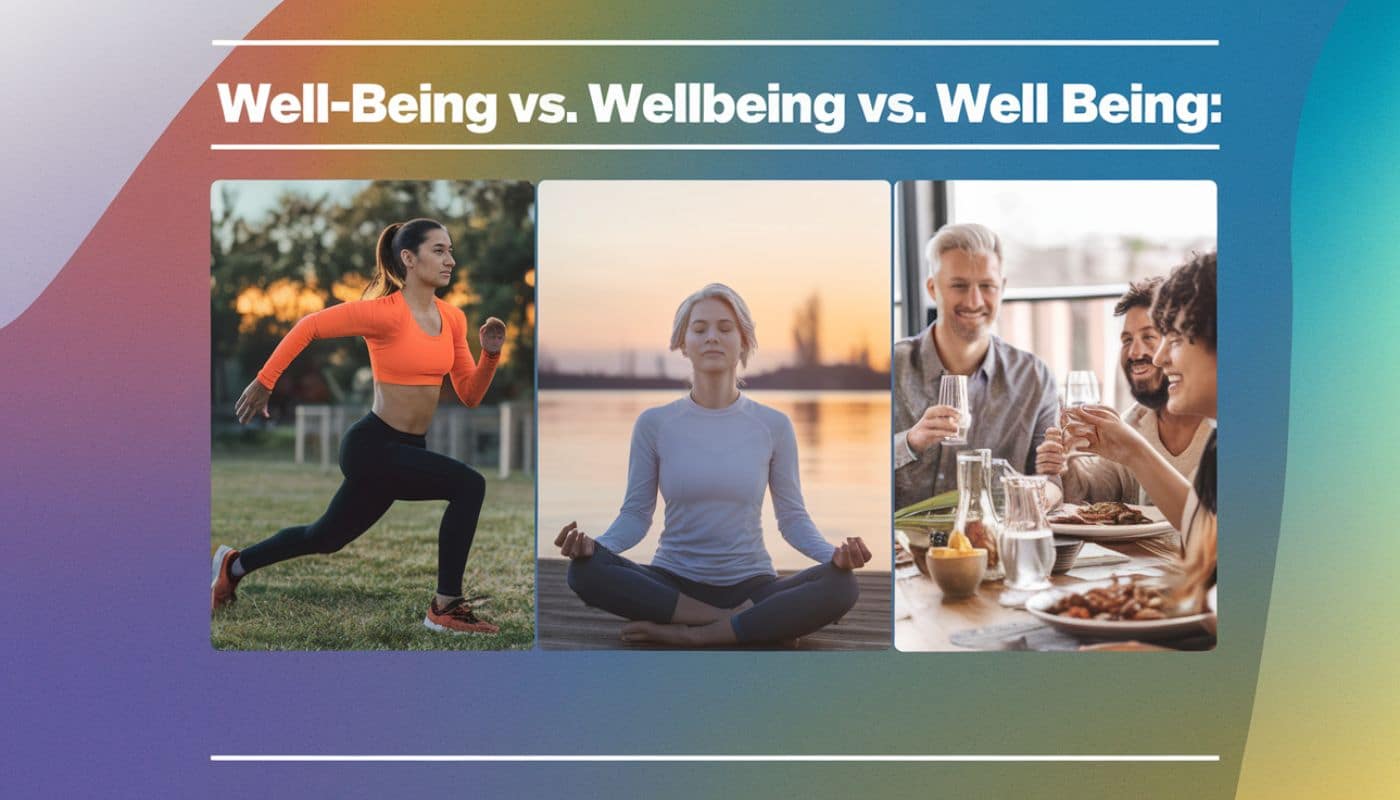In the world of language, certain terms evolve and shift, leaving even the most seasoned writers occasionally confused about the proper usage of words. One such term is well-being. If you’ve ever found yourself wondering whether to write wellbeing, well-being, or the more outdated well being, you’re not alone. These variations can create significant confusion, especially since the proper spelling often depends on context, region, and even formality.
In this comprehensive guide, we’ll explore the well-being vs. wellbeing vs. well being debate, breaking down their meanings, usage contexts, and regional preferences. By the end, you’ll be equipped with all the knowledge you need to use these terms correctly in both formal and informal writing.
What is Well-being?
Before we dive into the different variations, it’s important to understand what well-being actually means.
Meaning of Well-being
Well-being is a broad concept that refers to the state of being comfortable, healthy, or happy. It is used to describe an individual’s overall prosperity, covering both physical and mental health, happiness, and success. The term is often applied in various contexts, such as healthcare, social services, psychology, and even economics. Whether you’re talking about someone’s emotional well-being, psychological well-being, or their physical well-being, all these aspects contribute to a person’s total sense of well-being.
Here are some core meanings tied to well-being:
- Health: Refers to the physical state of being healthy, free from illness or injury.
- Happiness: An emotional state of contentment and joy, crucial to one’s mental well-being.
- Prosperity: The state of thriving or being successful, often tied to financial and social well-being.
- Welfare: A government’s responsibility to promote the well-being of its citizens, particularly in public health, education, and social services.
- Wellness: A holistic approach to health, covering physical, emotional, and mental aspects of well-being.
Related Terms and Synonyms for Well-being
As we talk about well-being, it’s essential to recognize its synonyms and related concepts. These words help add nuance and depth to discussions around well-being:
- Health: The absence of illness and the presence of physical vitality.
- Happiness: Emotional well-being, often intertwined with life satisfaction.
- Prosperity: Flourishing in life, including wealth and success.
- Welfare: Used more in governmental contexts to refer to public health and social support.
- Wellness: A more specific term that encompasses physical and mental health practices, often related to lifestyle and self-care.
The Three Variants of Well-being: Well-being, Wellbeing, Well Being
Now, let’s get into the heart of the matter—understanding when to use well-being, wellbeing, and well being. Each version of the word carries subtle differences in meaning and usage.

Well-being (Hyphenated)
Well-being (with the hyphen) is the most traditional and grammatically correct form of the term. It is widely accepted in both formal and academic contexts, especially in health, psychology, economics, and social studies. The hyphen separates the two components of the word—well and being—which helps clarify the meaning as a compound noun.
When to Use Well-being:
- Formal Writing: Used predominantly in academic, professional, and medical writing.
- Contextual Usage: Frequently used in discussions about emotional, psychological, and physical health.
- Examples:
- “Ensuring the well-being of employees is a critical goal for the company.”
- “The well-being of children should be the focus of any educational policy.”
Why the Hyphen Matters
The hyphen plays a key role in making the term a compound noun, combining well (healthy, good) and being (existence, state) into one cohesive idea. Without the hyphen, the meaning becomes less clear and may even be misinterpreted.
Wellbeing (Without the Hyphen)
The wellbeing variant is becoming increasingly popular, especially in informal and modern contexts. It’s the preferred form in British English and is often used in media, lifestyle blogs, and wellness-related content.
When to Use Wellbeing:
- Informal Writing: More common in blogs, websites, and casual articles related to health and wellness.
- Health and Lifestyle Content: Particularly used in the wellness community or in discussions on self-care, mental health, and holistic living.
- Examples:
- “Taking time for yourself is key to maintaining your wellbeing.”
- “Meditation and healthy eating contribute to a balanced wellbeing.”
Contextual Shifts
The use of wellbeing as a single word reflects how language is evolving. It is increasingly accepted in less formal settings, particularly when talking about personal health and wellness.
Well Being (Two Separate Words)
Well Being is considered an outdated or incorrect form in most contexts today. Though you might still see it used occasionally, particularly in older texts or by non-native English speakers, it is not grammatically accepted in modern English.
When Not to Use Well Being:
- Professional or Academic Writing: Avoid using “well being” in any formal writing.
- Inaccurate Usage: When attempting to communicate clearly and professionally, always opt for well-being or wellbeing.
- Examples:
- Incorrect: “The company focuses on the well being of its employees.”
- Correct: “The company focuses on the well-being of its employees.”
Regional Preferences: UK, USA, and Canada
While well-being is the standard form in most formal contexts, regional preferences also play a role in how the term is used.
| Region | Preferred Form | Notes |
|---|---|---|
| UK | Well-being (hyphenated) | Both well-being and wellbeing are used, but the hyphenated version is preferred in formal writing. |
| USA | Well-being (hyphenated) | The hyphenated form is the standard in all professional and academic writing. |
| Canada | Well-being (hyphenated) | Similar to the UK, both forms are used, but well-being is favored in formal contexts. |
When to Use Well-being in Writing

Choosing the correct form of well-being (or its variations) depends on the context, tone, and region of your writing. Below are some guidelines to help ensure you’re using the term appropriately.
Formal Contexts
- Use well-being (hyphenated) in academic papers, medical reports, and professional communications.
- Example: “The well-being of the elderly population is a growing concern.”
Informal Contexts
- Wellbeing (without the hyphen) is acceptable in more relaxed or casual writing, especially in lifestyle blogs, wellness content, and media.
- Example: “Good nutrition and exercise are key to maintaining your wellbeing.”
Common Mistakes: Avoiding Misspellings
A common error many people make is confusing well-being with wellbeing or even well being. While wellbeing has become increasingly popular in informal writing, well-being remains the grammatically correct form for most purposes. Here are a few tips to avoid common mistakes:
- Do not use “well being” (two separate words). It is considered incorrect in modern English.
- Stick to “well-being” for formal, professional, and academic contexts.
- Use wellbeing in informal, conversational, or lifestyle writing, where it’s widely accepted.
Well-being in Dictionaries
Dictionaries like Merriam-Webster, Oxford, and Cambridge provide definitions for well-being with an emphasis on the hyphenated version. Here’s a closer look at how these authoritative sources define well-being:
- Merriam-Webster: “The state of being happy, healthy, or prosperous.”
- Oxford English Dictionary: “The state of being comfortable, healthy, or happy.”
- Cambridge Dictionary: “The state of being happy, healthy, or successful.”
Emotional and Psychological Well-being

Emotional well-being and psychological well-being refer to one’s mental health and emotional resilience. Both aspects are crucial to overall well-being and affect one’s ability to cope with stress, maintain relationships, and navigate life challenges.
- Emotional well-being: Includes managing emotions, feeling content, and maintaining a positive outlook.
- Psychological well-being: Encompasses self-acceptance, personal growth, and the ability to engage meaningfully with life.
The Importance of Well-being in the Workplace
Corporate and organizational well-being has become a major focus in recent years. Employee well-being programs, which focus on both physical and mental health, have proven to increase productivity, reduce absenteeism, and improve morale.
Key Areas of Employee Well-being:
- Physical well-being: Ensuring employees have access to fitness programs and health screenings.
- Mental well-being: Providing resources for stress management and mental health support.
- Work-life balance: Encouraging flexible work schedules and time off to avoid burnout.
Conclusion: The Correct Way to Use Well-being
In summary, the term well-being is widely accepted in formal and professional contexts, with the hyphen serving to create a compound noun that conveys a clear and distinct meaning. Wellbeing, without the hyphen, is becoming increasingly common in informal writing, especially in the wellness and lifestyle sectors. On the other hand, well being (written as two separate words) is considered outdated and incorrect in modern usage.
When in doubt, always opt for well-being in formal writing, while reserving wellbeing for more casual settings. Remember, consistency is key to effective communication.
By understanding the distinctions between these forms, you can confidently use well-being in any writing context, whether you’re discussing physical health, emotional happiness, or personal prosperity.

Emily Hudson, the creative mind behind “English Summa,” is a passionate English language educator with a Bachelor’s Degree in English and a Teaching Certification. Dedicated to making the intricacies of English accessible to learners, Emily brings a blend of expertise and enthusiasm to her readers. Follow English Summa for insightful language tips, literary explorations, and a shared love for the beauty of English.






![# **25 Ways to Say “Have a Good Evening” Professionally** In professional communication, the way you bid farewell can leave a lasting impression. While “Have a good evening” is a polite and common phrase, it can sometimes feel generic or lack the personal touch needed to strengthen relationships. Whether you’re speaking to colleagues, clients, or business partners, tailoring your farewell to the context can demonstrate thoughtfulness, cultural awareness, and professionalism. This article explores **25 professional ways to say “Have a Good Evening”**, complete with real-world scenarios, cultural considerations, and tips to elevate your communication. By the end, you’ll have a toolkit of phrases to suit any professional setting, ensuring your farewells are memorable and meaningful. --- ## **Why Your Farewell Matters** The way you end a conversation or email is more than just a formality—it’s an opportunity to reinforce relationships, express gratitude, and set the tone for future interactions. A well-crafted farewell can: - **Show appreciation**: Acknowledge the time and effort of the person you’re speaking to. - **Reflect professionalism**: Demonstrate your attention to detail and cultural sensitivity. - **Encourage positivity**: Leave the other person feeling valued and respected. In professional settings, the right phrase can enhance your reputation and foster stronger connections. Let’s dive into 25 alternatives to “Have a Good Evening,” each tailored to different contexts. --- ## **25 Professional Ways to Say “Have a Good Evening”** ### **1. Wishing You a Productive Evening** **Scenario**: Email to a Team *“Hi Team, thank you for your hard work today. Wishing you a productive evening as you wrap up your tasks. Let’s regroup tomorrow with fresh energy!”* **Why It Works**: This phrase motivates your team to stay focused while acknowledging their efforts. --- ### **2. Have a Restful Evening** **Scenario**: Closing a Meeting *“Thank you all for your contributions today. Have a restful evening—you’ve earned it!”* **Why It Works**: It emphasizes the importance of recharging, which is especially meaningful after a long day. --- ### **3. Enjoy a Relaxing Evening** **Scenario**: Follow-Up Email to a Client *“Dear [Client’s Name], thank you for your time today. I hope you enjoy a relaxing evening. Looking forward to our next steps!”* **Why It Works**: It conveys warmth and shows you care about their well-being. --- ### **4. Wishing You a Serene Evening** **Scenario**: Email to a Senior Colleague *“Thank you for your guidance today. Wishing you a serene evening ahead.”* **Why It Works**: The word “serene” adds a touch of elegance and calmness, perfect for formal settings. --- ### **5. Here’s to a Gentle Farewell** **Scenario**: Networking Event *“It was a pleasure connecting with you tonight. Here’s to a gentle farewell—until next time!”* **Why It Works**: This phrase is warm and memorable, ideal for informal professional settings. --- ### **6. Wishing You Evening Wishes** **Scenario**: Formal Email Sign-Off *“Thank you for your time today. Wishing you evening wishes as you unwind.”* **Why It Works**: It’s unique and adds a personal touch to your communication. --- ### **7. Enjoy a Well-Deserved Break** **Scenario**: Team Chat After a Busy Week *“Great job this week, everyone! Enjoy a well-deserved break this evening.”* **Why It Works**: It acknowledges hard work and fosters team morale. --- ### **8. Take Care This Evening** **Scenario**: Email to a Colleague *“Thanks for your help today. Take care this evening, and I’ll see you tomorrow!”* **Why It Works**: It’s simple, friendly, and shows genuine concern. --- ### **9. I Hope You Have a Thoughtful Closing** **Scenario**: End-of-Day Recap *“As we wrap up, I hope you have a thoughtful closing to your day. Reflect on your achievements—you’ve done great work!”* **Why It Works**: It encourages mindfulness and self-appreciation. --- ### **10. May Your Evening Be Productive** **Scenario**: Informal Chat with a Colleague *“Before you head out, may your evening be productive! Let’s keep the momentum going.”* **Why It Works**: It’s motivating and keeps the focus on progress. --- ### **11. Here’s to a Positive End to the Day** **Scenario**: Team Meeting Conclusion *“Let’s toast to a positive end to the day! Thank you for your hard work, everyone.”* **Why It Works**: It fosters camaraderie and leaves a lasting impression. --- ### **12. Wishing You a Peaceful Evening** **Scenario**: Email to a Client *“Thank you for your time today. Wishing you a peaceful evening as you review the details.”* **Why It Works**: It’s respectful and creates a calming tone. --- ### **13. May You Enjoy Your Evening** **Scenario**: Closing a Conference Call *“Thank you for your valuable input today. May you enjoy your evening, and let’s touch base again soon!”* **Why It Works**: It leaves a warm impression, encouraging ongoing collaboration. --- ### **14. I Hope You Can Unwind** **Scenario**: Email to a Co-worker *“Thanks for your efforts on the project. I hope you can unwind this evening; you’ve certainly earned it!”* **Why It Works**: It shows empathy and understanding of the need for downtime. --- ### **15. Have a Calm Evening Ahead** **Scenario**: Follow-Up After a Presentation *“Great job today, team! Have a calm evening ahead, and let’s regroup tomorrow to discuss next steps.”* **Why It Works**: It promotes tranquility and sets a positive tone for the following day. --- ### **16. Here’s to a Fulfilling Evening** **Scenario**: Team Building Event *“Thank you for your participation! Here’s to a fulfilling evening with your loved ones. Remember, balance is key!”* **Why It Works**: It reinforces the idea of work-life balance, encouraging employees to value their personal time. --- ### **17. Wishing You Relaxation and Joy** **Scenario**: Informal Email *“Hey Jamie, I wanted to say thanks for your support on the project. Wishing you relaxation and joy this evening! You deserve it.”* **Why It Works**: This friendly approach fosters a positive rapport and acknowledges hard work. --- ### **18. May Your Evening Be Bright** **Scenario**: Casual Goodbyes *“Take care, everyone! May your evening be bright and filled with fun! See you all tomorrow.”* **Why It Works**: It adds a cheerful touch, enhancing workplace relationships. --- ### **19. Hoping You Enjoy a Pleasant Evening** **Scenario**: Formal Email *“Dear Ms. Harris, thank you for your continued support. I hope you enjoy a pleasant evening after a busy day.”* **Why It Works**: It maintains a formal yet warm tone, suitable for professional interactions. --- ### **20. Have a Wonderful Evening Ahead** **Scenario**: Conclusion of a Workshop *“Thank you all for your engagement today. Have a wonderful evening ahead; I look forward to seeing you at our next session!”* **Why It Works**: It encourages ongoing learning and connection. --- ### **21. Here’s to Kind Farewells** **Scenario**: Ending a Client Meeting *“Thank you for your time today. Here’s to kind farewells and a successful partnership moving forward!”* **Why It Works**: It emphasizes mutual respect and the importance of positive relationships in business. --- ### **22. Wishing You a Refreshing Evening** **Scenario**: Email to a Mentor *“Thank you for your advice today. Wishing you a refreshing evening—you’ve inspired me to approach things differently!”* **Why It Works**: It shows gratitude and acknowledges their impact. --- ### **23. May Your Evening Be as Rewarding as Your Day** **Scenario**: Email to a Hardworking Colleague *“Your dedication today was impressive. May your evening be as rewarding as your day!”* **Why It Works**: It’s a creative way to compliment their efforts. --- ### **24. Here’s to a Smooth Transition into Evening** **Scenario**: End of a Busy Workday *“Great work today, everyone. Here’s to a smooth transition into evening—see you tomorrow!”* **Why It Works**: It acknowledges the shift from work to personal time. --- ### **25. Wishing You a Joyful Evening** **Scenario**: Casual Team Chat *“Thanks for the laughs today, team. Wishing you a joyful evening—see you tomorrow!”* **Why It Works**: It’s lighthearted and fosters a positive team culture. --- ## **Cultural and Professional Considerations** When choosing how to say “Have a Good Evening,” consider the following: 1. **Cultural Sensitivity**: In some cultures, overly personal phrases may be seen as intrusive. Stick to neutral, respectful language in formal or cross-cultural settings. 2. **Hierarchy**: When addressing senior colleagues or clients, opt for more formal phrases like “Wishing you a serene evening” or “May your evening be productive.” 3. **Context**: Tailor your farewell to the situation. For example, after a stressful meeting, phrases like “Have a restful evening” or “I hope you can unwind” show empathy. --- ## **Conclusion** The way you say “Have a Good Evening” can significantly impact your professional relationships. By choosing the right phrase for the context, you can leave a positive, lasting impression that reflects your thoughtfulness and professionalism. Whether you’re addressing a team, a client, or a colleague, these 25 alternatives will help you elevate your communication and foster stronger connections. Next time you bid farewell, try one of these phrases and observe how it shapes the tone of your interactions. Remember, a thoughtful goodbye is more than just words—it’s an opportunity to show appreciation, build rapport, and leave a lasting impact.](https://englishsumma.net/wp-content/uploads/2025/02/25-Ways-to-Say-Have-a-Good-Evening-Professionally-In-professional-communication-the-way-you-bid-farewell-can-leave-a-lasting-impression.-While-Have-a-good-evening--150x150.jpg)







